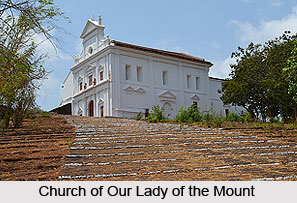 Church of Our Lady of the Mount in Goa was built in 1557. The church was built by Alfonso de Albuquerque after his victory over the Goan Muslim ruler Yusuf Adil Shah. This chapel is situated on a hill. The Chapel of Our Lady of the Mount faces the west which is endowed with beautiful views from Divar and Chorao islands, the Mandovi River and the surrounding forested hills. The church is brightly white washed. To reach this church one would have to travel for around 1.5 kms on the small mud road from the Old Goa circle.
Church of Our Lady of the Mount in Goa was built in 1557. The church was built by Alfonso de Albuquerque after his victory over the Goan Muslim ruler Yusuf Adil Shah. This chapel is situated on a hill. The Chapel of Our Lady of the Mount faces the west which is endowed with beautiful views from Divar and Chorao islands, the Mandovi River and the surrounding forested hills. The church is brightly white washed. To reach this church one would have to travel for around 1.5 kms on the small mud road from the Old Goa circle.
History of Church of Our Lady of the Mount
The chapel was build after the victory Portuguese nobleman Alfonso de Albuquerque over Yusuf Adil Shah. Alfonso de Albuquerque first launched his attack to take possession on Goa in March 1510. But this attempt was not successful. He launched his second attack on Goa on November 25, 1510. He was successful in taking possession of Goa from Yusuf Adil Shah in this attempt. The chapel on our lady of the Mount was built many years after the conquest of Goa to mark the places where Sultan Yusuf Adil Shah had placed his artillery to guard the city from the Portuguese attack.
Structure of Church of Our Lady of the Mount
The Church of Our Lady of the Mount represents the features of the Portuguese-influenced Christian religious architecture in Goa. The church is reached by the devotees by ascending a series of steps. These steps are built of laterite plastered with lime mortar. The church has three main altars which are dedicated to Our Lady of the Mount, St. Anthony and St. Andrew respectively.
Interiors of Church of Our Lady of the Mount
In the centre of the church the statue is erected of Our Lady of the Mount with the child Jesus. It is placed above the picture of the coronation of the virgin and below the picture of our Lady of Assumption. The pictures on either sides or those hung on the walls of the main altar depict the various acts of the life of Our Lady. At the base of the retable are the busts of St. Vincent along with a ship and of St. Lawrence with a gridiron. The collateral altars of the church are dedicated to St. Anthony and St. Andrew. Three sections with entrances on the ground floor and windows crowned by classic triangular pediments on the upper floor are topped by an additional central panel flanked by wings which hide the gable roof over the chapel body"s nave. The church was renovated in 2001.





















